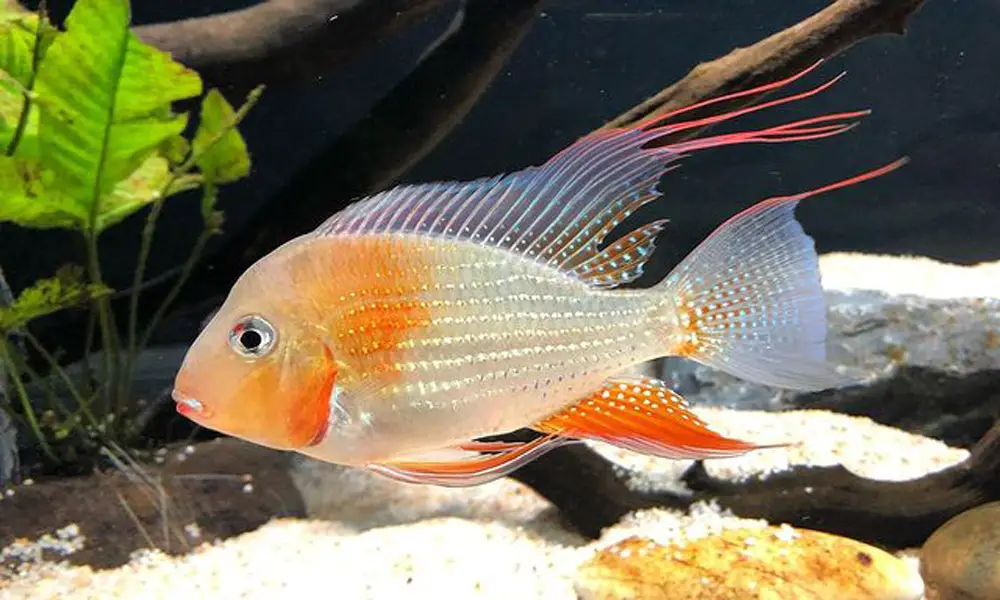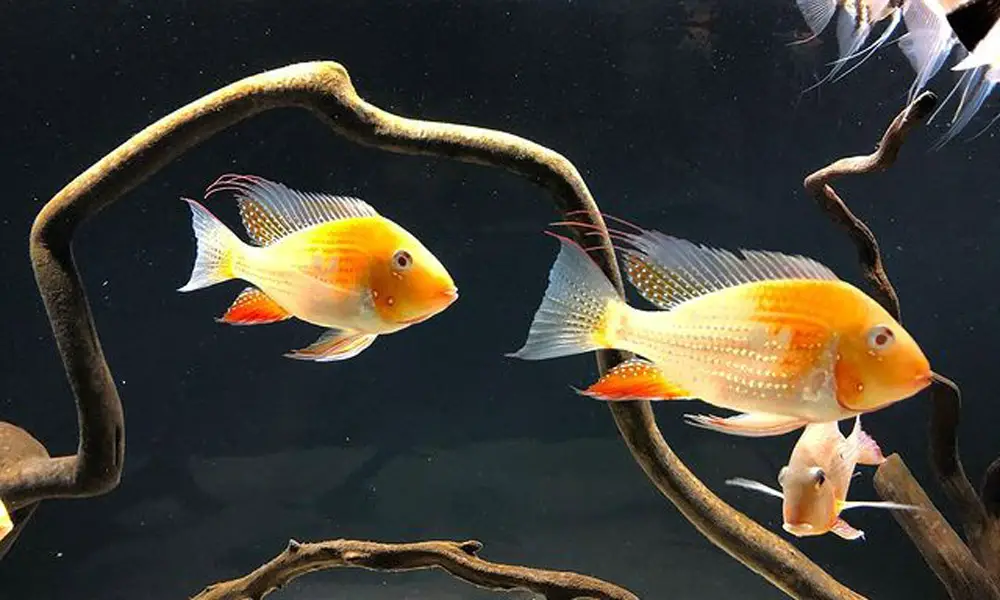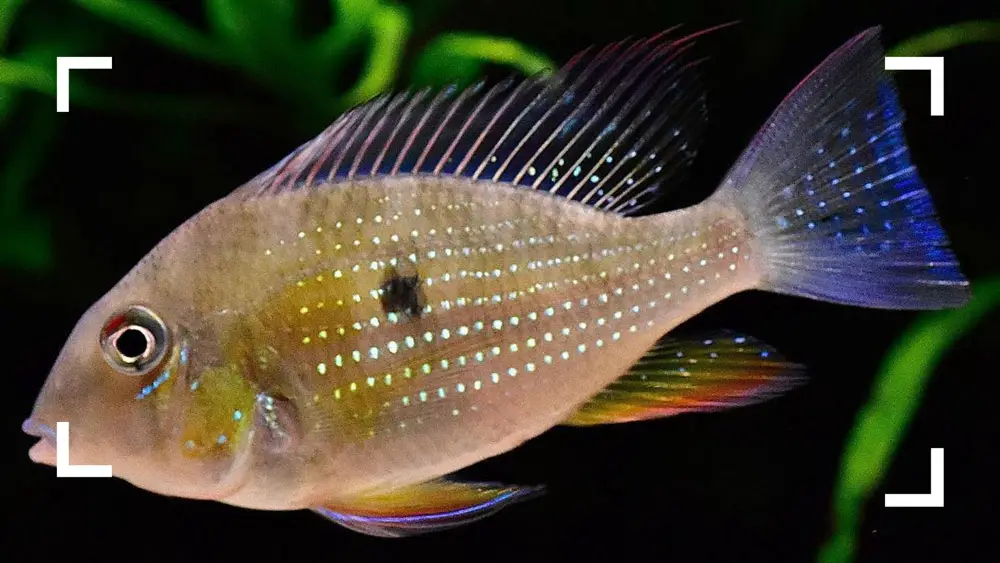The threadfin acara cichlid (Acarichthys heckelii) is a relatively peaceful species that is commonly found to add action and color to South American aquariums. It grows to a manageable size and is popular among aquarists for its incredible coloration and finnage.
However, getting them to breed may be difficult as they are known to be rather complex when it comes to spawning.
While these species are easy to care for, they still require some bare essentials to live comfortably in the aquarium space. This guide covers all Acarichthys Heckelii care fundamentals, including average size, appearance, ideal tank mates, water parameters, etc.
Species Summary
The threadfin acara (Acarichthys heckelii), sometimes referred to as Heckel’s thread-finned acara, is native to the northern parts of the Amazon Basin in Brazil, Columbia, and Peru. They are found in the lower Rio Capim, Rio Branco, Rio Trombetas, Rio Negro, Rio Putumayo, and Rio Xingo. In addition, they also inhabit the Essequibo River Drainage in Guyana.
It has been introduced to Singapore and other parts of Southeastern Asia. It is counted among the ten species of South American Cichlids to have been introduced in the southeastern part of Asia.
Acarichthys heckelii is the sole member of the Acarichthys genus, which was first introduced by the German Zoologists Troschel and JP Muller in 1848 as Acara heckelii. However, it is named after the Vienna Museum of Natural History director, Johann Jakob Heckel.
| Scientific Name: | Acarichthys heckelii |
| Common Name: | Threadfin Acara cichlid, Heckel’s thread-finned acara |
| Origin: | South American |
| Aggressiveness: | Semi-Aggressive |
| Size: | 8 inches (20 cm) |
| pH: | 6.0 – 7.2 |
| Temperature: | 77 to 88°F |
| KH: | 0 – 15 dKH |
| Minimum tank size: | 75 gallons |
| Diet: | Omnivorous |
Appearance

Threadfin Acara Cichlid is popular among cichlid enthusiasts for its vivid coloration as it matures. It is a deep-bodied, laterally compressed fish with a pale belly, brownish-silver upper body, and silvery flanks.
Adult threadfin acara species boast iridescent blue-green and bright yellow markings, along with violet, red, and orange highlights, especially in males. They feature a vertical black streak below their eyes and small black spots on the flanks below the mid-region of the dorsal fin.
Some specimens also have attractive gold to green patterns on their operculum and a black scar on the front few rays of the dorsal fin.
The most identifying feature of the Threadfin Acara is, as the name implies, their long and filamentous dorsal and anal fins. The males of the species have longer filaments than females.
Threadfin Acara (Acarichthys heckelii) Max Size
The average size of Acarichthys heckelii is about 8 inches (20 cm). However, in some instances, they can grow up to 10 inches. The average purchase size of Threadfin Acara Cichlid is around 2 – 2.5 inches (5.1 – 6.4cm).
Threadfin Acara has a moderate growth rate, and you can expect them to reach about 5 – 6 inches in a year. It takes almost 2 – 3 years to get their full potential size. In my first-hand experience, their growth rate slows down as they reach around 4 inches.
Like any other freshwater species, the frequency of water changes and diet play a major role in their growth rate. Regular water changes (10 – 20%) bi-weekly and a nutritious diet help them grow faster and stay healthy.
Lifespan
The average lifespan of threadfin acara Cichlid (Acarichthys heckelii) is between 8 to 10 years. Its longevity is due in part to its robustness and adaptability.
As always, the number is greatly impacted by the quality of care it receives and can vary enormously depending on tank conditions and general health.
Threadfin Acara (Acarichthys heckelii) Care
Threadfin Acara Cichlid care isn’t too challenging. They are less aggressive, unfussy species that can quickly adapt to standard aquarium conditions.
While juveniles and subadults are relatively peaceful, the behavior of adult individuals can be a bit unpredictable. They might show a certain level of aggression towards their own kind.
They should often be kept in groups and community tank setups. Below are mentioned a few care guidelines that you should keep in check before making a new addition.
Tanks Size
We recommend a tank size of at least 55 gallons (48″ x 13″ x 21″) for a single adult Threadfin Acara. However, if you plan on having an adult pair in your tank, then a 75-gallon (48″ x 18″ x 21″) is the bare minimum size.
While these dimensions are enough to keep a compatible pair, you need a significantly larger tank for a group of Acarichthys heckelii.
Water parameters
An ideal water condition is a must to keep these threadfin acaras feel healthy and happy. As tropical fish, these species prefer warm, soft, slightly acidic water, but not required.
These fish are gluttonous eaters and often generate a lot of waste, which in turn can quickly pollute the aquarium water. Strong filtration is required with moderate water movement.
Keep nitrate to a minimum as these species are susceptible to poor water conditions. Here’s mentioned the ideal water parameters that you should know:
- pH: 6.0 – 7.2
- Water Temperature: 77 to 88°F
- Hardness: 0 – 15 dKH
- Ammonia: 0 ppm
- Nitrite: 0 ppm
- Nitrate: <30 ppm
A good quality surface skimmer ensures that the water is clear for your Threadfin Acaras to swim and live in. To prevent deteriorating quality, we recommend you do bi-weekly water changes of 10-20%.
Decor (Plants and substrate)
In their natural habit, threadfins are found in shallow water with sandy-bottom rivers and ponds. To help your fish thrive in captivity, it’s best to try to recreate their natural habitat as closely as possible.
The aquarium space must be spacious and biologically mature to keep threadfin acara cichlid. As these species prefer sifting through the substrate in search of food, you can fill the aquarium with soft sand to ease their movement.
You should provide plenty of hiding places and visual barriers in the tank to reduce aggression. Driftwood, rocks, and live plants are excellent ornaments that help in providing these things.
Be sure to use tough plants that can withstand frequent substrate disturbance. Threadfin Acara is not known to eat live plants, but it does like to do some serious digging. Some good plant options include Java Fern, Anubias, and Bolbitis.
Threadfin acaras prefer the areas of low or subdued lighting where they can sit around for snacks, so don’t forget to incorporate dim-medium lighting into the tank.
Food
- New Life Spectrum is made from quality natural ingredients
- Extreme Color enhancement and vitality in your fish
- Made in the USA
Feeding Acarichthys heckelii is not a hassle for fishkeepers. They are gluttonous omnivores and generally feed at the bottom of the aquarium.
You can feed them with high-quality dry sinking pellets. To provide protein, offer up some live or frozen meaty foods, including white mosquito larvae, brine shrimp, daphnia, bloodworm, and black mosquito larvae.
Keeping their diet varied with vegetables like shelled peas, blanched spinach, and zucchini. You can also offer them some spirulina pellets that are rich in vegetables. Threadfin Acara will also nibble on algae wafers from time to time.
Threadfin Acara (Acarichthys heckelii) Tank Mates

This cichlid is compatible with other peaceful species of similar size. It is best to keep them in a group of 8 or more juveniles of similar size to meet their social needs. The more you add, the less aggression you will see. To keep them safe, we recommend you can keep them in species-only aquariums.
Some aquarists have had success with keeping Threadfin Acaras in community tanks. However, Threadfin Acara may become more aggressive towards other species as adults.
Depending on your tank size and stocking, you may be able to keep Threadfin Acara with fish enjoying similar water conditions. But, you should avoid any species known to be fin nippers, like many barbs and tetras. After all, their delicate, long finnage is one of the most beautiful features that make them visually appealing.
Some possible Threadfin Acara tank mates include:
- Guianacara species
- Mesoheros Ornatum (Ornatus Cichlid)
- Geophagus sp (G. altifrons | G. sveni)
- Hypselecara temporalis (Chocolate Cichlid)
- Silver Dollars
- Cory Catfish
- Headstanders
Breeding
Threadfin Acara cichlids are secretive substrate spawners that have an interesting reproductive strategy. Unlike most cichlids, the female Threadfin Acara will compete for territories when they reach sexual maturity at about 2 -3 years.
In the wild, the females are known for their elaborate spawning rituals, which involve intricately excavated burrows and plenty of theatrics to impress the males. These complex tunnels are usually compacted mixture of sand and mud, which come with some false entrances that lead nowhere to protect the eggs from getting eaten by predators.
But, an almost vertical main entrance shaft is crafted to access one of the horizontal tunnels at the end of which leads to its breeding chamber where the female will lay her eggs.
Then the female will try to choose a mate, and once successful, the pair set out. The female Threadfin can lay up to 2000 eggs, and she will be responsible for caring while the male stays outside and patrols a territory above the breeding chamber, almost 2-3m in diameter.
Once the fry is free-swimming, they will remain to stay close to the burrow and are protected by the parents until they reach about 10 mm. After that, the fry is abandoned and becomes fully independent. The fry is big enough to be fed newly hatched brine shrimp.
To trigger breeding in your Threadfin Acara cichlids, you should provide them with plenty of live foods and raise the water temperature to the higher side of the spectrum to 88°F for a few days. Then let the temperature drop to around 77°F for the next few days to simulate the wet season for spawning.
The complexity of the whole breeding process makes it impossible to breed Threadfin Acara in home aquariums. A single breeding pair will require a large aquarium to kick start the spawning process. Furthermore, a pair become extreme aggression towards any other Threadfin Acara or tank mates that dares to enter their territory. So, it is best to leave their breeding to professional aquaculturists.
Final Thoughts
Threadfin Acara cichlids (Acarichthys heckelii) are a popular freshwater fish species known for their striking features and interesting behavior. If you are thinking about adding them to your aquarium, always keep them in excellent water conditions as they are too sensitive to deteriorating conditions.
We hope you are now well-acquainted with the Threadfin Acara cichlids’ basic care fundamentals and make an informed choice accordingly. Caring for these species is not a challenge. You have to fulfill their basic needs to ensure their health and longer lifespan.
If you have any questions or suggestions, please feel free to share them with us in the comments section below.






